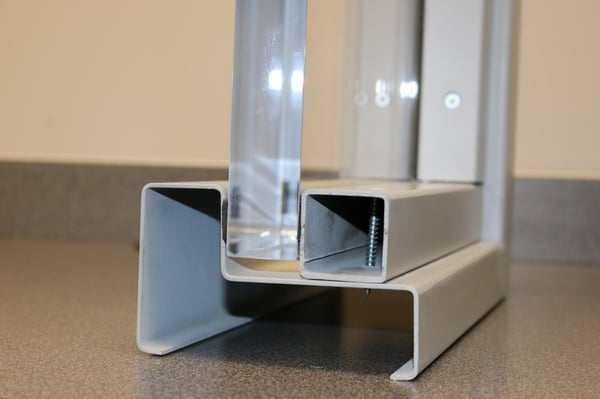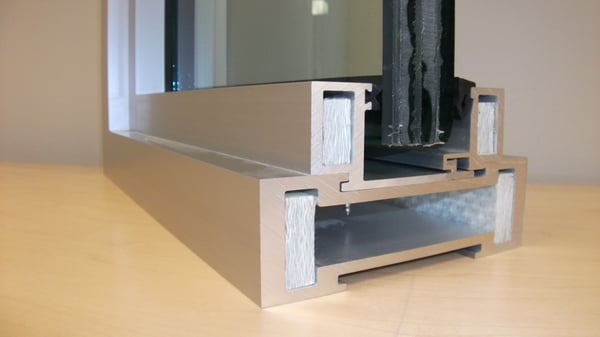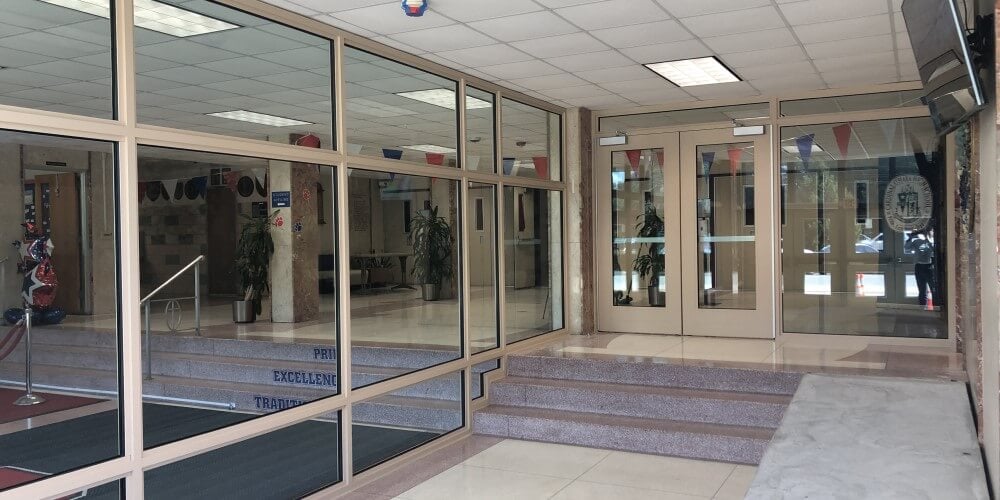In order to reliably increase building security, a barrier and access control system needs bullet-resistant frames for its ballistic doors and windows.
At one time, architects and builders had extremely limited options for such ballistic framing. Today, advancements in designs and fabrication techniques have expanded the options significantly. This expansion has primarily been in aluminum framing systems, which have seen the most innovation in the past decade. But more traditional “hollow metal” steel frames still have their place. In many cases, end-users are best served by mixing-and-matching framing systems. For example, a single building might have a large architectural "storefront" entryway with ballistic glass doors and UL-rated aluminum framing but then rely on more cost-effective hollow metal steel framing with standard steel ballistic doors for side entrances, loading dock doors, and so on.
The Basics of Hollow Metal Steel Bullet-Resistant Frames
Hollow metal frames, crafted from 16-gauge cold-rolled steel, have long been the standard form of ballistic framing for doors and windows. The combination of the hardness of the steel and the hollow design—which allows for reinforcement with ballistic fiberglass panels or armor plates—provides the needed protection where ballistically-rated doors or windows join the structure of the building.
Hollow metal frames offer several advantages for end users. The cold-rolled steel is affordable and extremely durable, making it a good choice for high-traffic areas or large buildings with many users. These frames are easy to maintain and repair (a dented frame can usually be hammered and filled, then painted to look like new). Hollow metal frames have an inherently industrial look that's easy to blend into existing structures that already rely on steel frames—provided an industrial look is right for your application.

That said, hollow metal frames are not themselves ballistically rated (although this is often rendered moot by the installation, where the frame overlaps a ballistically sound wall, for example). And they offer few performance options. For example, because of how hollow metal frames are manufactured, they offer less design flexibility and are not available in thermally insulated models.
In addition to these performance limitations, hollow metal framing can create logistic and installation challenges. Because they need to be welded, very little field assembly is possible. In general, complete pieces—such as entire door frames or fixed framed windows—must be shipped install-ready. This also means that fabrication must be extremely precise, as modifying the finished pieces in the field is rarely possible. It's almost always easier to change the dimensions of the hole you're cutting in the wall than it is to change the dimensions of a finished hollow metal frame.
Hollow Metal Ballistic Framing Challenges
Total Security Solutions recently worked with a school in Pennsylvania that needed a secure interior airlock vestibule at their primary entrance. Given the building layout, this was a fairly straightforward design: they would leave the existing non-rated exterior doors in place and install a rated bullet-resistant barrier across the width of the front hall. The ballistic doors in this new bulletproof glass wall would be controlled from the adjacent office, which would also be renovated to include a check-in transaction window installed through the wall dividing the entryway hall and main office.
The school wanted a hollow metal framing system to match the rest of the building (which had steel frames on its doors and windows). But they also needed to minimize any other building modifications. Ideally, they wanted a ballistic glass curtain wall that was roughly 20 feet wide, more than 8 feet tall, had broad doors with electric strikes and could be set in place and secured without further construction. Such a curtain wall, spanning the width of a hall this size, relies on a single-piece frame.
This highlights the importance of working with a ballistic solutions vendor like TSS. An experienced bulletproofing company draws on decades of experience to reliably construct even very large components that don’t simply meet the spec, but also accommodate the realities of walls and ceilings (which are never perfectly plumb or square, regardless of what the schematic says).
But even when a vendor can supply a large single-piece frame that will fit snugly into a school entry, a component that large cannot be economically shipped. TSS was able to engineer a hollow metal ballistic frame that would meet their security goals and require the fewest possible field welds. They then guided the installation process to minimize hassle and avoid additional construction.
The Basics of Aluminum Ballistic Framing Systems
Aluminum bullet-resistant frames are often called storefront frames because they look similar to the non-rated aluminum framing used in most retail entrances.
True UL-rated aluminum frames (like those made by TSS) will usually cost more than hollow metal steel frames. But in many applications, they are a much better value. UL-rated aluminum frames offer much greater design flexibility, allowing for a sleeker, more pleasing aesthetic.
It's easier to turn corners and create corner posts when working in aluminum, vastly increasing your options during retrofits and renovations. For example, working with aluminum ballistic framing systems you can break up large or historic spaces to channel visitors through a checkpoint or vestibule, add security booths or secured reception desks, and so on.
More importantly, with aluminum framing, you can take a systems approach to both physical security and design. Because field assembly is no problem, logistics become much simpler. Systems can be larger, taller, and wider. It's not unusual to build a twenty- or thirty-foot tall curtain wall with aluminum framing, using different glazing in different parts of the system.
Most importantly, aluminum framing systems are higher-performance solutions. TSS's extruded aluminum TSS-BL1.75 and TSS-BL2.5 framing systems provide tested UL Level-3 security (stopping any conventional pistol). The TSS-BL5.5 ballistic framing system is likewise made from ballistically rated extruded aluminum. But in this case, both the threat side and secure side of the frame are also backed with a ballistic fiberglass panel (as shown in the cross-section below). This increases the ballistic performance of the frames so that they can stop shots from high-powered rifles as well as pistols (thus meeting the requirements of UL Levels 4 through 8).

Thermal Ballistic Framing Systems in Aluminum
Aluminum framing systems can also perform beyond their bullet resistance. For example, the TSS-650 system offers protection up to UL Level 8 (stopping shots from AK-style rifles and other long guns, as well as all types of pistol fire) while providing an insulated thermal break between the building interior and exterior.
The TSS-650 was originally designed for areas where extreme weather caused issues with conventional aluminum framing systems (which tend to be continuous through the wall). TSS CEO Jim Richards began work on what ultimately became the TSS-650 thermal framing system after he spoke with a customer in North Dakota who had problems with large amounts of frost and ice—sometimes up to half an inch thick—building up on the inside of their ballistic aluminum frames during the winter.
In the years since, TSS has been pleasantly surprised to see a very broad adoption of their thermal-break framing system. For example, TSS just completed a project for a school in New England that needed a three-story glass facade. By using the TSS-650 ballistic framing system, TSS was able to offer a structural framing system that created the aesthetics the school wanted and still meet all of its ballistic and insulation performance goals. Owing to the flexibility of the TSS-650 system, TSS could also help contain costs and minimize installation hassles by strategically mixing ballistically rated and non-ballistically rated glazing. For example, while all of the ground floor windows were ballistically rated and forced-entry rated, some inaccessible upper-story windows could be swapped out for more appropriate non-rated glazing.
Let TSS Put Its Expertise to Work for You
In order to get the best results for their clients and the ultimate users of a building, a good bulletproofing company needs to take a collaborative approach. That can have a very long timeline—which some organizations shy away from. But TSS is always eager to join the process as early as possible. For example, it isn't unusual for Total Security Solutions to work with an architect or builder for years as the project evolves in order to ensure the final barrier system best suits the building and its users.
Have something in mind? Contact our ballistic security experts if you have questions or want to get started with a specific project.

